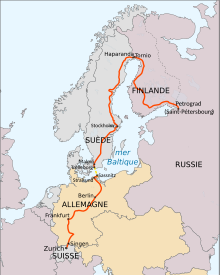
Summary
A sealed train is one that travels internationally under customs and/or immigration seal, without its contents legally recognized as entering or leaving the nations traversed between the beginning and end of the journey or subject to any otherwise applicable taxes.[citation needed]

Background edit
The most notable use of a sealed train was the return of Vladimir Lenin to Russia from exile in Switzerland in 1917—in fact that journey was not a true sealed train example because the passengers disembarked to spend the night in Frankfurt[1]—but the practice was used a number of times throughout the 20th century to allow the migration or transport of controversial individuals or peoples. For instance, sealed trains were used for repatriation of combatants in the Spanish Civil War,[2] Jewish emigration from Nazi Germany to the United States,[3] and expulsion of East German refugees to West Germany.[4]
References edit
- ^ Ted Widmer (20 April 2017). "Lenin and the Russian Spark". The New Yorker. Retrieved 26 November 2019.
- ^ Rosenstone, Robert A. Crusade of the Left. Transaction Publishers. p. 337. ISBN 978-1-4128-2080-6.
- ^ Staff (16 February 1941). "Hundreds of Jews Leave Reich in Sealed Train to Emigrate Overseas". Jewish Telegraphic Agency. Retrieved 4 May 2014.
- ^ Protzman, Ferdinand (6 October 1989). "Jubilant East Germans Cross to West in Sealed Trains". The New York Times. p. 8.
See also edit


